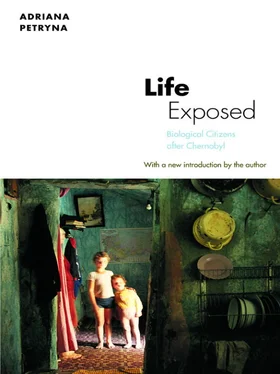The exchange of measures noted above occurred in a context of humanitarian relief established by the United Nations and its subsidiary groups. Accordingly, an international Chernobyl Fund was set up in 1991 to provide monitoring and health care for the people still residing in contaminated zones. Representatives of the World Health Organization who took part in the International Chernobyl Project recommended the following: a long-term epidemiological study, an investigation of the psychosocial health effects, a retrospective analysis of dose intake to sharpen the biodosimetry related to those effects, and the establishment of radiation health data banks.
By 1995, however, the Chernobyl Fund was out of money. The undersecretary-general for humanitarian affairs of the United Nations and spokesman for the fund stated that in most catastrophes, officials can sooner or later see an end to suffering and dislocation. “It is not easy to see an end here…. In fact, we don’t really know where we are in the process” (Crossette 1995:All). According to one scientist affiliated with the project, most American life scientists interested in Chernobyl are finding less and less funding for studies related to that accident.
Life overcomes error through further trials (and by error I mean simply a dead end). (Canguilhem 1994:318) [32] “If life is the production, transmission and reception of information, then clearly the history of life involves both conservation and innovation. How is evolution to be explained by genetics? The answer, of course, involves the mechanism of mutation…. To be sure, many mutations are monstrous—but from the standpoint of life as a whole, what does monstrous mean? Many of today’s life forms are nothing other than normalized monsters…. Thus, if life has meaning, we must accept the possibility of a loss of that meaning, of distortion, of misconstruction. Life overcomes error through further trials (and by error I mean simply a dead end)” (Canguilhem 1994:318).
When I first traveled to Kyiv in 1992, I had to consider seriously some of the unknowns related to this ethnographic work, especially the possibility of my own exposure to low-level radiation and related risks. The U.S. State Department’s travel advisories made no mention of risk; Ukraine was and is deemed safe for travel. In a 1988 article in Science , Anspaugh and colleagues of Lawrence Livermore National Laboratory were already saying: “Probably no adverse health effects will be manifest by epidemiological analysis in the remainder of the Soviet population or the rest of the world. Projections of excess cancer risk for the Northern Hemisphere range from an incremental increase of 0% to 0.003%” (1988:1518). [33] In citing what Anspaugh and colleagues have claimed, I am aware that the quoted zero percent figure, the bottom of the range, does not make sense here.
An additional 0.003 percent of cancer deaths caused by Chernobyl among the approximately five billion residents of the Northern Hemisphere would be about 150,000 deaths. When I talked about safety measures with a representative of the World Health Organization, I was told that “flying to Denver was more dangerous in terms of radiation exposure than entering Ukraine.” That same year (1993), I bought a personal dosimeter and wore it on my chest all summer. It registered nothing unusual.
Nevertheless, there are currently almost no foolproof measures for ascertaining claims regarding radiation (particularly low-dose) from Chernobyl. Biodosimetric systems have changed over time, depending on the nuclear event. For example, there is one system related to the bombings at Hiroshima, but for the Chernobyl accident, a different system is being devised. The absence of a standard measure of threshold dose and its biological relevance has serious consequences not only for interpreting the medical effects of exposure to radiation released during the Chernobyl accident but also for the acceptance of the medical status of that nuclear event itself. [34] According to Pass et al., “Quantification of the biologically relevant dose is required for the establishment of cause-and-effect radiation detriment or burden and important biological outcomes” (1997:390).
In addition, the absence of an agreed-upon set of biological criteria in experimental organisms makes it difficult for scientists to scale up estimates of radiation effects for individuals and populations. Not only does the mutability of species of organisms differ, “but there are a number of intervening steps that will influence the frequency of mutations observed and…. the type of mutation event scored by a particular test will determine the mutability of the genetic endpoint screened” (Favor 1989:844). What is meant by genetic or biological end-points?
To find out, during spring 1995, I attended weekly meetings of the Radiation Biology Group of the Life Sciences Division of the Lawrence Berkeley National Laboratory (LBL) on the University of California campus. At the time, this group consisted of radiation biologists, radiologists, and biophysicists, whose research methods aimed to represent quantified independent causal realities in the form of linear energy transfers (LETs), and the mechanisms of radiation damage and repair processes in a one-to-one linear model (that is, the dose-response curve). NASA funded the group’s study of the health effects of protons and high-energy heavy ions of the kind encountered by astronauts in space travel, and the space agency also supports its efforts to define relevant experimental endpoints for carcinogenetic processes. The group relied heavily on the BEVALAC, a large-particle accelerator and source of LETs for animal experiments on the LBL campus. [35] The BEVALAC was considered the only suitable accelerator for comprehensive studies of heavy ions. The decommissioning of the BEVALAC in 1994 put significant constraints on animal studies, as well as on experimental radiation therapy for terminally ill cancer patients at LBL.
At the weekly meetings, individual scientists made presentations on their work in radiation biology, cell death, and DNA damage related to cancer formation.
As part of experimental design, each investigator studies what is biologically turned on and off, and the types of genetic products produced, when LETs are applied at a specific rate and dose to experimental organisms, usually mice. LETs at the biological target are counted from the residual range of LBL’s eighty-eight-inch cyclotron beam line. The mice are sacrificed, and the necessary biological material is harvested, frozen, sectioned, stained, mounted, and photographed. Reactivity to radiation exposure is measured by observed changes as biological events at selected endpoints: immunoreactivity of proteins and cell kill.
Other important endpoints include mechanisms of DNA repair after irradiation. Radiation induction is known to cause breaks in DNA, and so much of the experimental activity of the radiation biology group focuses on providing information on the induction of DNA damage in patented human cells by exposing those cells to high LETs and determining the extent to which that damage can be modified by natural DNA repair processes. After irradiation, researchers construct a dose-response curve by noting induction, cell survival, damage, and repair of DNA breaks according to LET dose. They measure breaks in the arms of specific chromosomes using techniques such as pulsed field gel electrophoresis and Southern hybridization. Gene-specific probes are used to demonstrate biological “slow spots” and “hot spots” for repair.
Some of the rationale behind the investigation of DNA damage and repair relates to the current Department of Energy-specified need to identify biological forms of dose monitoring that could be used as a base for designating threshold measures for individuals and populations exposed at lower doses. The model assumes that biological monitors, if identified correctly, can predict future radiation-related health risks in an individual person or human population.
Читать дальше












